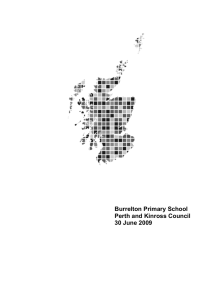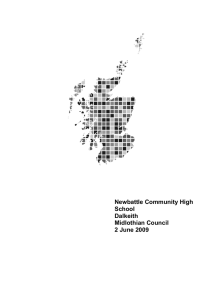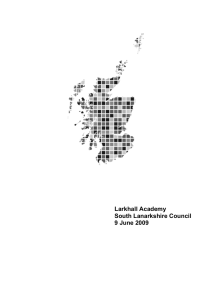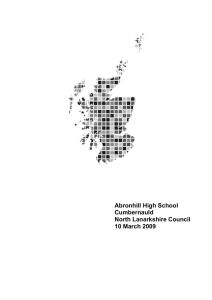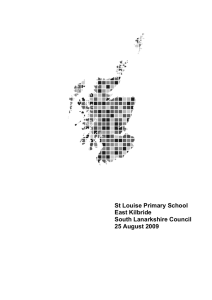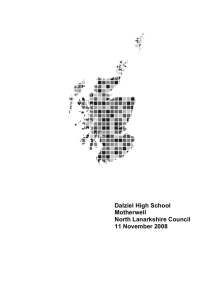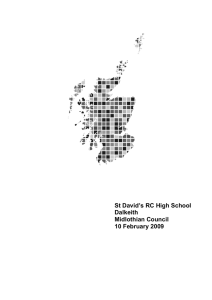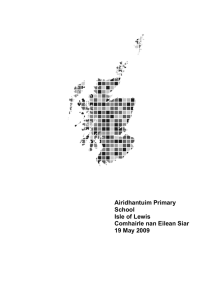Shawlands Academy Glasgow City Council 5 May 2009
advertisement
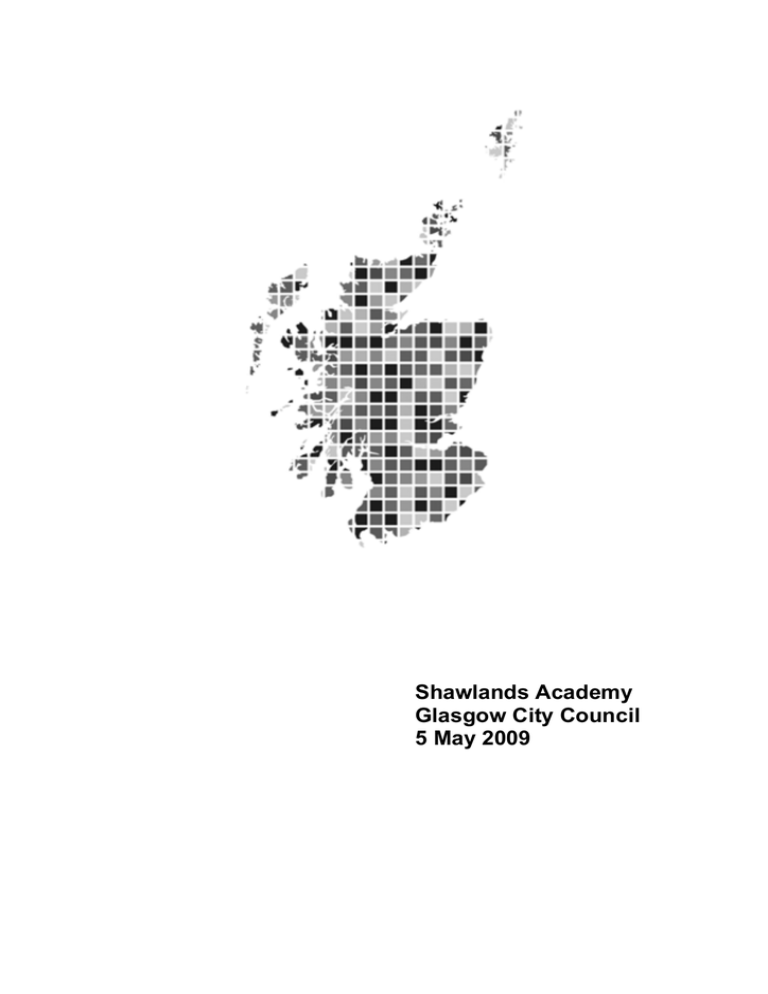
Shawlands Academy Glasgow City Council 5 May 2009 This report tells you about the quality of education at the school. We describe how young people benefit from learning there. We explain how well they are doing and how good the school is at helping them to learn. Then we look at the ways in which the school does this. We describe how well the school works with other groups in the community, including parents1 and services which support young people. We also comment on how well staff and young people work together and how they go about improving the school. Our report describes the ‘ethos’ of the school. By ‘ethos’ we mean the relationships in the school, how well young people are cared for and treated and how much is expected of them in all aspects of school life. Finally, we comment on the school’s aims. In particular, we focus on how well the aims help staff to deliver high quality learning, and the impact of leadership on the school’s success in achieving these aims. If you would like to learn more about our inspection of the school, please visit www.hmie.gov.uk. Here you can find analyses of questionnaire returns and details about young people’s examination performance. Where applicable, you will also be able to find descriptions of good practice in the school and a report on the learning community surrounding the school. 1 Throughout this report, the term ‘parents’ should be taken to include foster carers, residential care staff and carers who are relatives or friends. Contents 1. The school 2. Particular strengths of the school 3. Examples of good practice 4. How well do young people learn and achieve? 5. How well do staff work with others to support young people’s learning? 6. Are staff and young people actively involved in improving their school community? 7. Does the school have high expectations of all young people? 8. Does the school have a clear sense of direction? 9. What happens next? 1. The school Shawlands Academy is a non-denominational school which serves the south east of Glasgow including Newlands, Shawlands, Strathbungo, Govanhill and the Gorbals. The roll was 1232 when the inspection was carried out in February 2009. Around half of the young people have English as an additional language. A number of young people have only been in Scotland for a short time. A number are also from transient families. This impacts on attendance levels. Young people’s attendance was below the national average in 2007/2008. The school has a co-located Additional Support for Learning/English as Additional Language (ASL/EAL) Secondary Support Service: the Bilingual Support Unit. This is a city-wide provision for young people who are new arrivals to the country with little or no English. 1 2. Particular strengths of the school • The richness of cultural diversity in the school community. • The high-quality attainment and achievement. • The quality of the Secondary Support Service’s work in supporting young people with EAL. • Young people’s understanding of global citizenship, equality, sustainable education and environmental issues. • The promotion of health and wellbeing. • The headteacher’s vision and direction for the school. 3. Examples of good practice • International education. • Sustainable education. 4. How well do young people learn and achieve? Learning and achievement Most young people are determined to do well. They are motivated, confident and friendly. Young people show respect for each other and staff. Most feel safe, secure and well cared for. Young people participate well and enthusiastically in discussions and group activities, enjoy learning and think that the school is making them more confident. In some lessons, they have very good scope to become independent, active and engaged in learning. This good practice needs to be extended. Young people are not always sure how to improve their learning. Teachers need to involve them more in setting targets and reviewing their own learning. 2 Young people are increasing their confidence and developing their citizenship skills through participating in a wide range of activities. These include international education projects which increase their awareness of anti-racism, international cooperation, human rights and environmental issues. They have very many opportunities to take on leadership roles. They act as ambassadors for the school on the many international visits which take place. They have participated in a United Nations debate on sustainable education, and an Inclusion and Diversity in Education project in the European Parliament. Young people’s team working, creative and personal skills are developing very well in residential visits, enterprise tasks and a range of charitable work, sports and arts activities. These and other activities also develop their personal responsibility, confidence and health and wellbeing. Young people’s successes are recognised through awards including the UK Sustainable Schools Award and the British Council’s Award for Excellence in International Education. At S1/S2, reading and writing is improving with around half of young people now achieving appropriate levels. The majority achieve appropriate levels in mathematics. In other subjects, the majority are making good progress in their classwork. The school’s performance is variable at S3/S4. It performs very well at S5/S6 in comparison to schools which serve young people with similar needs and backgrounds. The small numbers of young people who follow practical, skills-based programmes are making good progress in the Duke of Edinburgh’s Awards and Princes Trust XL. Young people with additional support needs are doing well. Those who are still at the early stages of acquiring English are making good progress in their social skills. Many young people who receive support from the ASL/EAL Secondary Support Service achieve very well across the curriculum as a result of this support. The school has been very successful in helping high numbers of young people go onto university, college, training and employment. 3 Curriculum and meeting learning needs The school provides a very good range of courses and activities which give young people choices and progression in many aspects of their learning. The study of languages is given a central place in their learning. Opportunities to develop skills in enterprise, sustainable development, global citizenship and employability are well developed. Courses promote academic and more practical skills as appropriate to individuals’ needs. The school is developing well its approaches to preparing young people for life after school and the world of work. Staff have developed courses to better meet the needs of young people through extending the range of provision at Access 3 and Intermediate 1 levels. Young people’s needs for quality physical education are met very well in S1 to S4 but not at S5/S6. Staff across the school know the young people and their learning needs very well. Support for learning staff provide helpful information about young people to enable teachers to meet their learning needs. When teachers plan well, the tasks and activities chosen are very well matched to learning needs, but this is not consistent across the school. At times, particularly in S1/S2, tasks do not challenge young people enough and do not build effectively on their previous learning experiences. Increasingly, the range of services from within and outwith the school works well to support young people. The school should continue to improve the range and types of support available for young people. The ASL/EAL Secondary Support Service enables young people to learn English in a supportive environment. Staff are very committed to the young people and provide them with very good programmes of study and support to help develop their social and academic language. Both the ASL/EAL Secondary Support Service and the EAL staff assess the needs of young people well. EAL staff should continue to ensure they help teachers across the school to develop their skills in supporting bilingual learners. 4 5. How well do staff work with others to support young people’s learning? The Parent Teacher Council supports the school very well. Parents feel welcomed in the school and they think that progress reports and parents’ evenings are informative. They are informed about school events including through the informative website and newsletters. A few parents would like communication to be better and to get more information on their child’s progress in learning. The school has a very good range of effective partnerships to enhance young people’s learning, including a joint assessment team. Young people in S4 successfully mentor their younger peers to help them settle into school. The very strong links with local businesses and employers have successfully focused on employability and enterprise activities. 6. Are staff and young people actively involved in improving their school community? Staff are very committed to improving the life and work of the school. Many support the extensive range of out-of-school activities for young people. Teachers contribute well to working groups and lead the development of important improvement priorities. The pupil councils and the Eco Group are active in making school improvements. They regularly discuss aspects of the life of the school. The school is successfully developing its approaches to self-evaluation. Senior managers visit classes to observe learning and staff identify and share good practice. Staff are developing their skills in analysing attainment information. The school regularly gathers the views of staff, parents and young people. Evidence gathered is used to set priorities for the improvement plan. These arrangements have led to improvements in learning and teaching and to the curriculum. Staff have identified the need to develop further approaches to track young people’s progress and achievements. Staff now need to continue to improve their approaches to self-evaluation and apply them consistently across the school. 5 7. Does the school have high expectations of all young people? Relationships between adults and young people are positive. The school is developing its approaches to support individuals who need to improve their behaviour. The school has a commendable range of activities which promote race equality and respect for cultural diversity very well, including through a focus on international education. Most staff have high expectations of young people’s learning and behaviour and use praise well to encourage them to succeed. Staff are actively taking steps to improve young people’s attendance. The school has effective procedures for dealing with complaints from parents and young people. Staff understand and implement procedures to safeguard young people’s health and wellbeing. Young people are very positive about the wide range of opportunities the school offers to promote a healthy lifestyle. They have appropriate opportunities for religious observance. The building is not fully accessible to those with restricted mobility. 8. Does the school have a clear sense of direction? The headteacher has a clear vision for the school. She has developed her vision and the values and aims for the school in consultation with staff, young people and parents. She provides very strong leadership and direction and has successfully secured staffs’ shared commitment to school improvement. The school is committed to further developing positive links with the community and other partnerships to enhance its life and work. As a team, the depute headteachers provide strong leadership across the school. The principal teachers are developing their leadership for learning and should continue to develop their role in improvement through self-evaluation. The school has a strong capacity to improve. 6 9. What happens next? As a result of the very good quality of education provided by the school, we will make no further visits in connection with this inspection. The education authority will inform parents about the school’s progress as part of the authority’s arrangements for reporting to parents on the quality of its schools. We have agreed the following areas for improvement with the school and education authority. • Continue to improve young people’s progress, achievements and attendance through improving monitoring and tracking. • Continue to improve the consistency and quality of young people’s learning experiences through improving self-evaluation. Quality indicators help schools, education authorities and inspectors to judge what is good and what needs to be improved in the work of the school. You can find these quality indicators in the HMIE publication How good is our school?. Following the inspection of each school, the Scottish Government gathers evaluations of three important quality indicators to keep track of how well all Scottish schools are doing. Here are the evaluations for Shawlands Academy. Improvements in performance Learners’ experiences Meeting learning needs very good good good We also evaluated the following aspects of the work of the school. The curriculum Improvement through self-evaluation HM Inspector: Mary Hoey very good good 5 May 2009 7 To find out more about inspections or get an electronic copy of this report go to www.hmie.gov.uk. Please contact the Business Management and Communications Team (BMCT) if you wish to enquire about our arrangements for translated or other appropriate versions. If you wish to comment about any of our inspections, contact us at HMIEenquiries@hmie.gsi.gov.uk or alternatively you should write in the first instance to BMCT, HM Inspectorate of Education, Denholm House, Almondvale Business Park, Almondvale Way, Livingston EH54 6GA. Our complaints procedure is available from our website www.hmie.gov.uk or alternatively you can write to our Complaints Manager, at the address above or by telephoning 01506 600259. If you are not satisfied with the action we have taken at the end of our complaints procedure, you can raise your complaint with the Scottish Public Services Ombudsman (SPSO). The SPSO is fully independent and has powers to investigate complaints about Government departments and agencies. You should write to SPSO, Freepost EH641, Edinburgh EH3 0BR. You can also telephone 0800 377 7330, fax 0800 377 7331 or e-mail: ask@spso.org.uk. More information about the Ombudsman’s office can be obtained from the website at www.spso.org.uk. This report uses the following word scale to make clear judgements made by inspectors. excellent very good good satisfactory weak unsatisfactory outstanding, sector leading major strengths important strengths with some areas for improvement strengths just outweigh weaknesses important weaknesses major weaknesses Crown Copyright 2009 HM Inspectorate of Education. 8
